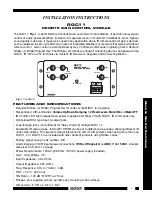
Heat Manager Pro User Manual V1.5 Page 11
GLOSSARY
In this manual we make use of common terminology that is used for temperature control in
general.
Auto hold
This function is used to hold the programmer when the measured value of
the programmer (or one of its slaves) deviates more than the adjusted
values from the current actual set value. When all measured values are
within the so-called deviation band the programmer will automatically
continue and start changing the set values.
Burnout
Sensor state that occurs when the electrical connections of the sensor
are not correct anymore (e.g. broken thermocouple or badly welded
thermocouple).
CSV file
Comma Separated Values file that can be imported into a spreadsheet
program (e.g. Microsoft Excel). See the manual of the corresponding
program for more information on how to do this. Also see the extra
chapter about this at the end of this manual.
History
The history refers to information from the past about the actual state of
the process. In the case of the Heat Manager we refer to the measured
process values of a running process which are stored in the non-volatile
memory of the Heatmanager Pro. These values can be exported to a
USB-stick as a so-called CSV file.
Manipulated value
The actual output percentage of a controller, also known as the controller
output or MV. This value ranges from 0.0 to 100.0% and depends on the
deviation between the actual set value and process value, corrected with
historical information from the past via the PID settings.
PID
Response settings of a controller channel. See the end of this manual for
more detailed information about these settings.
Process value
The value that is currently measured inside the process under control,
also known as PV or the measured value.
Profile
The profile is a combination of set values over time that the programmer
will send to its slaves. This is also known as a program or a recipe.
Programmer
The programmer is a channel that is using the profile for sending set
values to controllers that are connected to its slaves (when present).
Ramp
This is the rate of change per hour used by a programmer to increase or
decrease its set value.












































